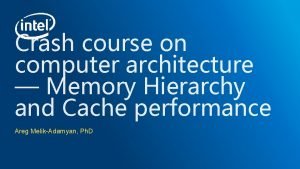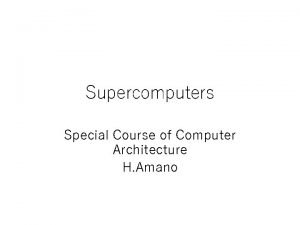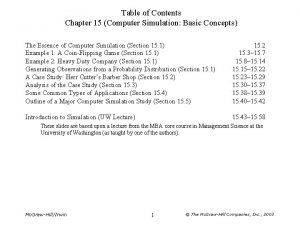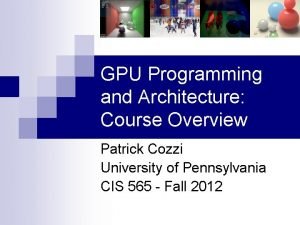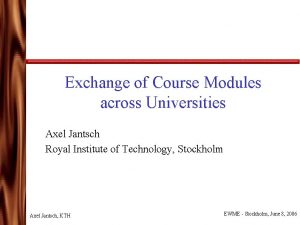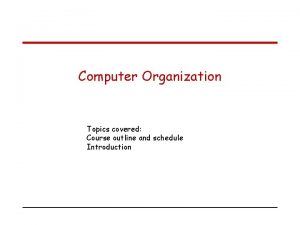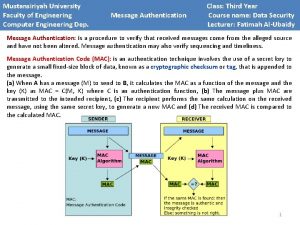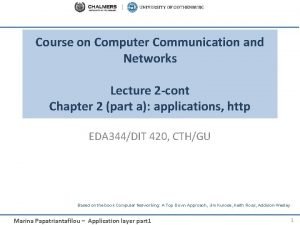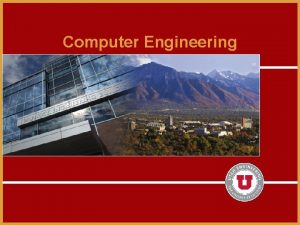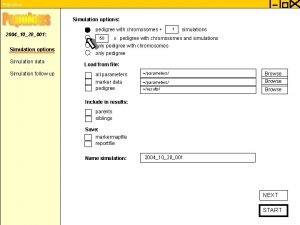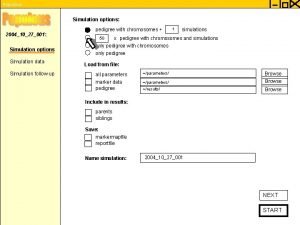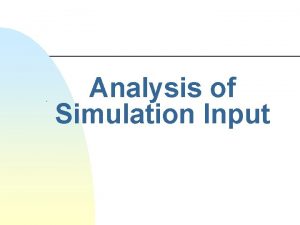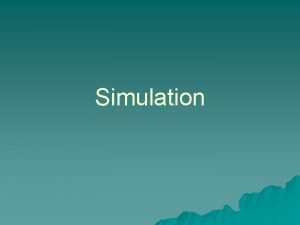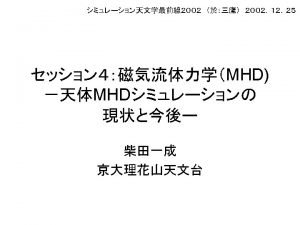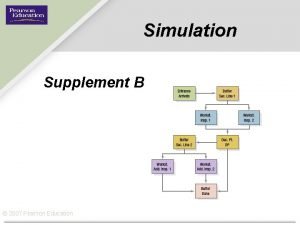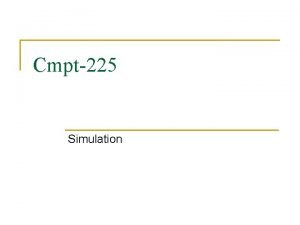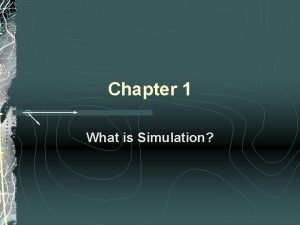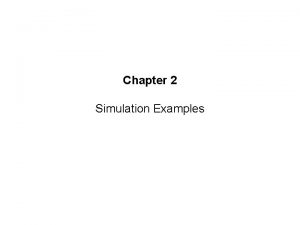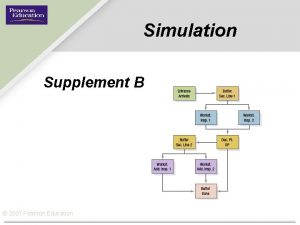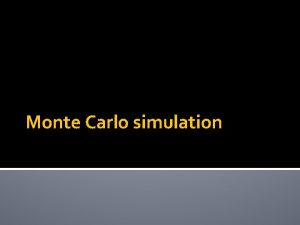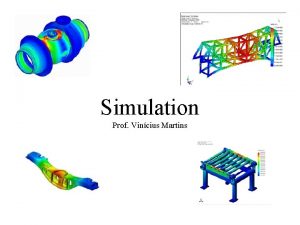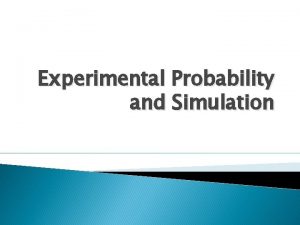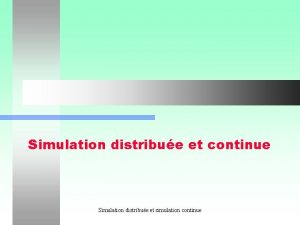Special Course on Computer Architecture 7 Simulation of
































- Slides: 32

Special Course on Computer Architecture #7 Simulation of Multi-Processors Hiroki Matsutani and Hideharu Amano June 3 rd, 2011 Special Course on Computer Architecture 1

Outline: Simulation of Multi-Processors • Background – Recent multi-core and many-core processors – Network-on-Chip • Shared-memory chip multi-processors – Architecture – Coherence protocols • Simulation environment: GEMS/Simics • Exercises [50 min] – Performance evaluation of parallel applications – Performance evaluation of coherence protocols June 3 rd, 2011 Special Course on Computer Architecture 2

Number of PEs (caches are not included) Multi- and many-core architectures 256 pico. Chip PC 102 pico. Chip PC 205 Clear. Speed CSX 700 128 64 Intel 80 -core TILERA TILE 64 Clear. Speed CSX 600 Intel SCC 32 16 MIT RAW UT TRIPS (OPN) STI Cell BE 8 Sun T 1 4 2 2004 2006 Sun T 2 Fujitsu SPARC 64 Intel Core, IBM Power 7 AMD Opteron 2008 2010 2011

Network-on-Chip (No. C) • Interconnection network to connect many-cores Core June 3 rd, 2011 Router 16 -Core Tile Architecture Special Course on Computer Architecture 4

On-chip router architecture 1) selecting an Input ports output channel 2) arbitration for the selected output channel Output ports ARBITER X+ X+ FIFO X- Y+ FIFO 3) sending the packet Yto the 5 x 5 output channel FIFO CROSSBAR YCORE GRANT CORE Routing, traversal are. Architecture performed in pipeline manner June 3 rd, arbitration, &switch 2011 Special Course on Computer 5

Outline: Simulation of Multi-Processors • Background – Recent multi-core and many-core processors – Network-on-Chip • Shared-memory chip multi-processors – Architecture – Coherence protocols • Simulation environment: GEMS/Simics • Exercises [50 min] – Performance evaluation of parallel applications – Performance evaluation of coherence protocols June 3 rd, 2011 Special Course on Computer Architecture 6

Today’s target architecture • Chip multi-processors (CMPs) – Multiple processors (each has private L 1 cache) – Shared L 2 cache divided into multiple banks (SNUCA) Processor tile Cache tile Ultra. SPARC L 1 cache (I & D) L 2 cache bank June 3 rd, 2011 Special Course on Computer Architecture 7

Today’s target architecture • Chip multi-processors (CMPs) – Multiple processors (each has private L 1 cache) – Shared L 2 cache divided into multiple banks (SNUCA) – Processors and L 2 cache banks are connected via No. C Processor tile Cache tile Ultra. SPARC L 1 cache (I & D) L 2 cache bank On-chip router June 3 rd, 2011 Special Course on Computer Architecture 8

Cache coherence is maintained • Write back policy – Cache-write updates the memory when block is evicted • Write invalidate policy – Cache-write invalidates all copies of the other sharers Processor tile Cache tile June 3 rd, 2011 Main Memory Special Course on Computer Architecture 9

Cache coherence is maintained • A CPU wants to read a block cached at – The CPU sends a read request to the memory controller – The controller forwards the request to current owner – The owner sends the block to the requestor Processor tile Cache tile June 3 rd, 2011 Main Memory Special Course on Computer Architecture 10

Cache coherence: MOESI protocol class Status of each cache block is represented with M/O/E/S/I • Modified (M) • Owned (O) – Modified (i. e. , dirty) – Valid in one cache • Shared (S) – Shared by multiple CPUs • Exclusive (E) – Clean – Exists in one cache • Invalid (I) June 3 rd, 2011 – May or may not clean – Exists in multiple caches – Owned by one cache • Owner – Responsibility to respond any requests • MOESI protocols – MSI, MOSI, – MESI, MOESI, … Special Course on Computer Architecture 11

Cache coherence protocols • MSI/MOSI directory protocol – E state is not implemented – S-to-M transition always updates the main memory • MESI directory protocol – O state is not implemented; Dirty sharing not allowed – M-to-S transition always updates the main memory • MOESI directory protocol • MOESI token protocol [Martin ISCA 03] – There are tokens as many as the number of CPUs – A CPU has one or more tokens It can read the block – A CPU has all tokens It can modify (write) the block June 3 rd, 2011 Special Course on Computer Architecture 12

MSI Protocol: State transition Cpu. Rd --Cpu. Wr --- Cpu. Rd --- M S Cpu. Wr Bus. Wr Cpu. Rd Bus. Rd I M S Bus. Rd Flush Bus. Wr --- I Bus. Rd --Bus. Wr --- S-to-M transitions flush (update) the main memory Y. Solihin, "Fundamentals of Parallel Computer Architecture" (2009).

MESI Protocol: State transition Cpu. Rd --Cpu. Wr --- Cpu. Rd --- M E Cpu. Wr --Cp u. W Cpu. Rd r Cpu. Wr Bu s. W Bus. Rd(!C) Bus. Upgr r S Cpu. Rd --- Cpu. Rd Bus. Rd(C) I M E S I Bus. Wr Bus. Rd Flush. Opt Flush Bus. Rd Bus. Wr Flush. Opt Bus. Rd --Bus. Wr --Bus. Upgr --- M-to-S transitions flush (update) the main memory Y. Solihin, "Fundamentals of Parallel Computer Architecture" (2009).

MOESI Protocol: State transition (1/2) Cpu. Rd --Cpu. Wr Bus. Upgr O Cpu. Rd --- M Cpu. Wr --- E Cp u. W r Cpu. Rd Bu Cpu. Wr s. W Bus. Rd(!C) r Bus. Upgr S Cpu. Rd Bus. Rd(C) I Cpu. Rd --- Y. Solihin, "Fundamentals of Parallel Computer Architecture" (2009).

MOESI Protocol: State transition (2/2) Bus. Rd Flush O Bus. Rd Flush M Bus. Wr Bus. Rd Flush. Opt Flush S Bus. Rd Flush. Opt E Bus. Wr Flush. Opt I Bus. Rd --Bus. Wr --Bus. Upgr --- Bus. Wr Flush Bus. Upgr --Y. Solihin, "Fundamentals of Parallel Computer Architecture" (2009).

Outline: Simulation of Multi-Processors • Background – Recent multi-core and many-core processors – Network-on-Chip • Shared-memory chip multi-processors – Architecture – Coherence protocols • Simulation environment: GEMS/Simics • Exercises [50 min] – Performance evaluation of parallel applications – Performance evaluation of coherence protocols June 3 rd, 2011 Special Course on Computer Architecture 17

Full-system simulation: GEMS/Simics • Wind River’s Simics – Commercial detailed processor simulator • Univ. of Wisconsin’s GEMS – Cache, memory, and network module for Simics Processor tile Cache tile Main Memory Ultra. SPARC L 1 cache (I & D) L 2 cache bank On-chip router June 3 rd, 2011 Special Course on Computer Architecture 18

Full-system simulation: GEMS/Simics • Today’s simulation target – Solaris 9 OS on eight Ultra. SPARC processors – Parallel application examples: Pi and Integer sort – Various coherence protocols are supported Processor tile Cache tile Main Memory Ultra. SPARC L 1 cache (I & D) L 2 cache bank On-chip router June 3 rd, 2011 Special Course on Computer Architecture 19

Full-system simulation: GEMS/Simics • Simulation target – Solaris 9 OS on eight Ultra. SPARC processors – Parallel application example: Integer Sort (IS) Solaris 9 is running on 8 -core Ultra. SPARC Processor tile Cache tile Main Memory Ultra. SPARC A parallel program L 1 cache (I & D) Compile L 2 cache bank On-chip. Execute routerit with 8 -core June 3 rd, 2011 Special Course on Computer Architecture 20

Parallel application example: Open. MP #include <stdio. h> #include <omp. h> int main() { #pragma omp parallel printf("hello world from %d of %dn", omp_get_thread_num(), omp_get_num_threads()); return 0; } Hello from all threads

Parallel application example: Open. MP int main() { int i; double start_time, end_time; start_time = omp_get_wtime(); omp_set_num_threads(num); #pragma omp parallel shared(A) private(i) { #pragma omp for (i = 0; i < N; i++) A[i] = A[i] * A[i] - 3. 0; } end_time = omp_get_wtime(); printf("Elapsed time: %f secn", end_time - start_time); return 0; }

Parallel application example: Open. MP int main() { int i; double s = 0. 0; double start_time, end_time; start_time = omp_get_wtime(); #pragma omp parallel private(i) reduction(+: s) { #pragma omp for (i = 0; i < N; i++) s += (4. 0 / (4 * i + 1) - 4. 0 / (4 * i + 3)); } printf("pi = %lfn", s); end_time = omp_get_wtime(); printf("Elapsed time: %f secn", end_time - start_time); }

Outline: Simulation of Multi-Processors • Background – Recent multi-core and many-core processors – Network-on-Chip • Shared-memory chip multi-processors – Architecture – Coherence protocols • Simulation environment: GEMS/Simics • Exercises [50 min] – Performance evaluation of parallel applications – Performance evaluation of coherence protocols June 3 rd, 2011 Special Course on Computer Architecture 24

The first step: How to use the simulator • Please pick up your account information • Log-in one of ICS cluster machines (id = 01… 15) ssh –X <username>@cluster<id>. ics. keio. ac. jp • Copy sample scripts and configuration files cp –r ~matutani/comparch 2011/files work cd work June 3 rd, 2011 Special Course on Computer Architecture 25

The first step: How to use the simulator • Start Simics. /start_ideal_memory. sh • You can use the gray window as a console of the target system (i. e. , Solaris 9 on 8 -core Ultra. SPARCs). June 3 rd, 2011 Special Course on Computer Architecture 26

The first step: How to use the simulator • In the target machine, for example, you can check the number of processors as follows. bash-2. 05# /usr/sbin/psrinfo -v You will see that there are eight processors June 3 rd, 2011 Special Course on Computer Architecture 27

Parallel application: “pi” calculation • You can execute a "pi" calculation program using eight, four, and one threads. bash-2. 05# export OMP_NUM_THREADS=8 bash-2. 05#. /pi bash-2. 05# export OMP_NUM_THREADS=4 bash-2. 05#. /pi bash-2. 05# export OMP_NUM_THREADS=1 bash-2. 05#. /pi June 3 rd, 2011 Special Course on Computer Architecture 28

Parallel application: Integer Sort (IS) • You can execute an Integer Sort (IS) program using eight, four, and one threads. bash-2. 05# export OMP_NUM_THREADS=8 bash-2. 05#. /IS bash-2. 05# export OMP_NUM_THREADS=4 bash-2. 05#. /IS bash-2. 05# export OMP_NUM_THREADS=1 bash-2. 05#. /IS June 3 rd, 2011 Special Course on Computer Architecture 29

Exercise 1 • Report the execution time of “pi” using 1, 4, 8, and 16 threads. Does the execution time linearly decrease as the number of threads increase? Discuss the results. June 3 rd, 2011 Special Course on Computer Architecture 30

Coherence protocols: Integer Sort (IS) • The following scripts automatically perform the IS program with different cache coherent protocols. . /start_moesi_directory. sh. /start_msi_mosi_directory. sh. /start_moesi_token. sh • Each simulation takes five to ten minutes. Do not run more than one scripts at the same time! June 3 rd, 2011 Special Course on Computer Architecture 31

Exercise 2 • Report the execution time of MSI/MOSI directory, MESI directory, MOESI directory, and MOESI token. Discuss the results. For more detail about the protocols, you can see pages 14— 19. June 3 rd, 2011 Special Course on Computer Architecture 32
 Computer architecture crash course
Computer architecture crash course Three bus architecture
Three bus architecture Difference computer organization and architecture
Difference computer organization and architecture Interrupt cycle flow chart
Interrupt cycle flow chart Peta
Peta Sailor course brick
Sailor course brick Course title and course number
Course title and course number Course interne course externe
Course interne course externe Computer simulation
Computer simulation Computer simulation
Computer simulation Githubn
Githubn Axel computer course
Axel computer course Computer system course
Computer system course Computer organization course
Computer organization course Computer engineering course
Computer engineering course Monashportal
Monashportal Computer communication course
Computer communication course What is architecture business cycle
What is architecture business cycle Data centered architecture
Data centered architecture Examples of integral product architecture
Examples of integral product architecture Types of modular architecture
Types of modular architecture Computer organization and architecture 10th solution
Computer organization and architecture 10th solution Ocs architecture
Ocs architecture Ripple carry adder virtual lab
Ripple carry adder virtual lab Introduction to computer organization and architecture
Introduction to computer organization and architecture Timing and control in computer architecture
Timing and control in computer architecture Evolution of computer architecture
Evolution of computer architecture I/o modules in computer architecture
I/o modules in computer architecture Fp adder
Fp adder Wipro
Wipro Static interconnection network in computer architecture
Static interconnection network in computer architecture Smt in computer architecture
Smt in computer architecture Li mips instruction
Li mips instruction
